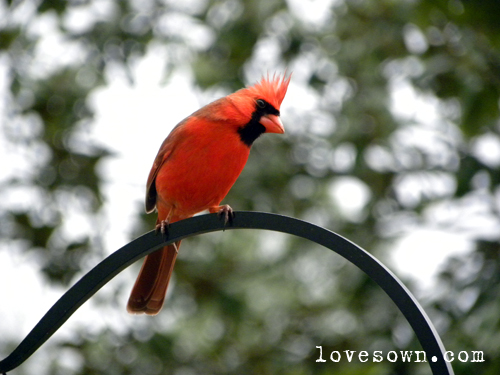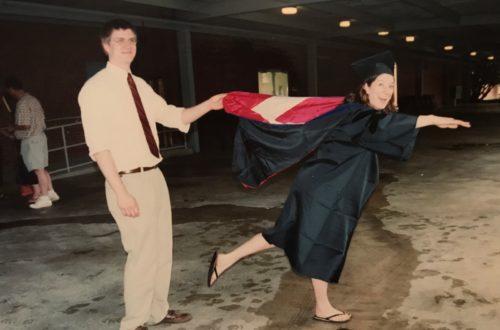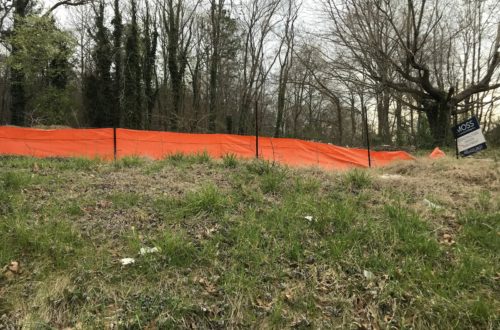Growing Habitat
The first time I saw a male cardinal perched in the peach tree I had planted in the back yard, I couldn’t help feeling a little light-hearted. I was actually so excited that for a moment I contemplated interrupting Joe at work to tell him there was a bird in my tree. What made me most excited was seeing that this tree, which I had planted to commemorate a baby lost to miscarriage, was no longer my tree. It had been adopted as part of the growing habitat in our back yard.
Everything we do to the land on which we live shapes, alters and transforms habitats. When we took down nineteen pines over a year ago, we changed the landscape. We mainly saw crows perched in those trees, but as the smaller hardwoods gained more access to sunlight, they filled out. With the feeders, a couple fruit trees and cedars and breeding boxes we added, more birds have been attracted to our yard. I may regret this later in the summer when I see wedged pecks in each two-days-till-ripe tomato.
Just yesterday, I was walking past a tall hibiscus hedge, when I saw a mother robin feeding her fledgling. As I poked my head up through the branches, she took off as the little one hopped to a higher limb fluttering its slightly unstable yet completely capable wings. I’ve seen this same family of robins nesting on the neighbor’s downspout and standing on the garden fence with worms dangling from their beaks. They have become used to seeing me too.
As the habitat becomes more enhanced, I find that I spend more time outside listening and observing. I learn to recognize the difference between the chirps of an angry titmouse and a nervous house wren. I learn to respect the bees as they go about their work on the flowers I planted just so they’d come and make my garden more fruitful. I teach my boys to make sure they don’t hold worms too long before letting them wriggle back into the garden soil. Together we inspect mysterious holes in the ground and ponder what type of critters live in them. We also learn about life and tragedy such as when we discovered the nest full of baby newly-hatched chickadees had been vacated.
For me, living in the middle of a city, I consider it a joy to spend time tending to the land, hearing noises of the interstate mingle with noisy chirps of the finch family descending on the deck feeder. I also see it as my duty to teach my sons how to care for it as well. At first, the boys see a pile and dirt and shovels and envision mass destruction and pushing around their dump trucks. But after awhile, they begin searching for worms, planting seeds, watering plants, helping me fill the feeders, and climbing trees. I love hearing my four year old explain how the plant roots drink water and how weeds take away all the water. He’s growing observant eyes and a better understanding of the connectedness of the land.




6 Comments
The Conservationist
We prize the shrubs that house nests. I put out a bird house with Autumn after painting it happy colors, hoping to attract more birds to our veggie bed area. Might you do a post on ideas for providing welcome to birds and other wild creatures in the man-ordered garden? I would love that.
Ruth
I am relearning nature as I go about trying to create a garden. I am aware of completely different things than I was before and am finding that patients is the most important thing.
We also have nesting birds, inside a hollow fence pole of all places, and I am wondering if I should put up feeders to attract more. I would love to, but I have cats, and they love birds…
paige.puckett
Danielle, I saw a post somewhere on creating lizard habitats. I'll have to do some searching.
Ruth, my cat loves birds too and has caught several – only killing one that I know of. I try to avoid letting her outside during the main feeding times. I also put a little jingle on on her collar.
Ruth
I think I might adopt the bell strategy. My cats won't like it for exactly the same reason me and the birds will 🙂
Cathy and Steve
What an incredible photo of a cardinal. We have a family of cardinals here, but I can never get such a wonderful picture of the male or the female. Great job!
paige.puckett
Thanks, Cathy and Steve! Male cardinals are so hard for me to photograph. Usually they come out looking iridescent when I snap them. I think the trick is getting soft backlight so he isn't reflecting so much.